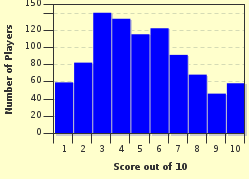Quiz Answer Key and Fun Facts
1. When looking at the elastic properties of solids, Hooke's law states that for a spring which stays within its elastic limit, the extension produced is directly proportional to the force which causes it. However, at what point will a spring not return to its original length?
2. The electromagnetic spectrum is made up of many wavelengths of light. As wavelength increases, frequency decreases. Which of these has a higher frequency than visible light?
3. When light passes from one boundary to another it will be refracted if the two mediums are of different density. If the medium into which the ray of light is entering is denser than the medium it is leaving, the light ray will be refracted towards the normal (a line 90 degrees to the change of boundary). If a greater difference in density results in greater refraction, which of the following is true?
4. If a ray of light is travelling through a dense core, comes to a boundary with a less dense cladding and the angle of incidence is greater than the critical angle, what will occur?
5. As suggested by Planck and Einstein, light can behave as a particle. This can be displayed by the photo-electric effect. This is the emission of electrons from a metal surface due to the energy provided by light incident on its surface. What is the name of the forces between the electron and nuclei which must be overcome to allow for the emission of photo-electrons?
6. Electrons in an atom can move in fixed orbitals, Different orbitals have different energies.
How does this allow a fluorescent tube to glow?
7. Ernst Rutherford proved many things about the structure of an atom due to the results from the experiment in which he fired alpha particles (a helium nucleus) at a thin gold leaf. Some of the alpha particles were deflected back along the path which they came. What did this deflection show Rutherford?
8. For every particle (e.g. protons, neutrons and electrons) there is an antiparticle with identical mass and equal and opposite charge. When a particle and its antiparticle come into contact they cease to be matter as their energy is given of as photons of light. What is this known as?
9. Feynman diagrams can be used to show how sub-atomic particles can be converted into other sub-atomic particles. The majority of Feynman diagrams show one particle being converted to another by an exchange particle, which then decays into leptons (e.g. electrons and positrons). Which exchange particle is involved in "beta+ decay", "electron capture" and "neutron-neutrino collision"?
10. Particles can be classified as leptons (e.g. electrons) or hadrons. Leptons are described as fundamental particles as they cannot be broken down into simpler particles. Hadrons can be baryons (e.g. protons and neutrons) or mesons (e.g. pions or kaons). Baryons are made up of 3 quarks. How many quarks make up a meson?
Source: Author
doublemm
This quiz was reviewed by FunTrivia editor
crisw before going online.
Any errors found in FunTrivia content are routinely corrected through our feedback system.

